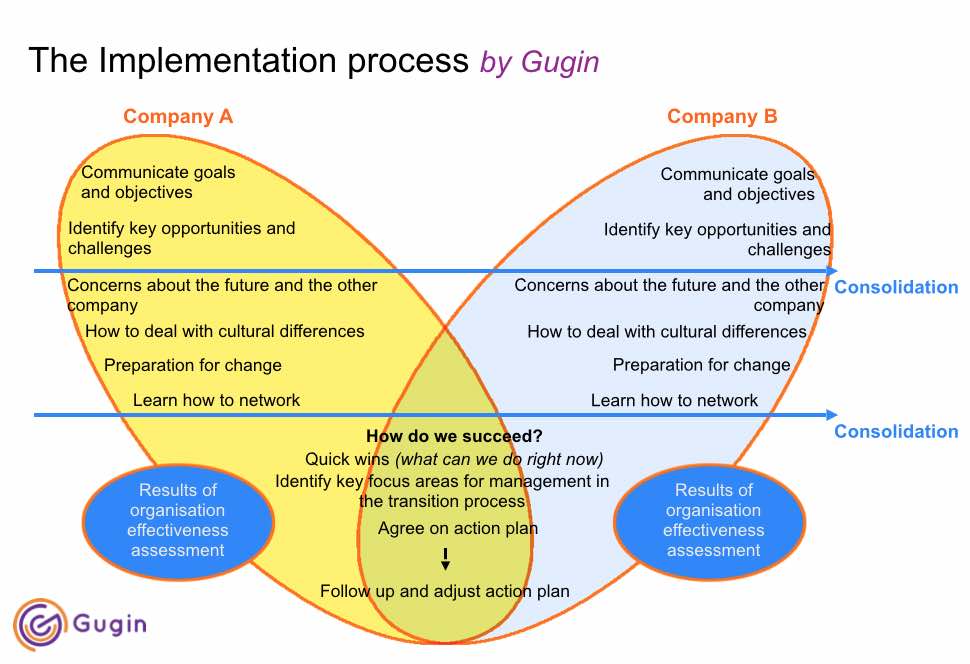Corporate culture integration is crucial when merging two organisations. Did you know that 2/3 of all mergers and acquisitions fail to meet their original objectives due to cultural clashes? They fail because the organisations involved don’t have the expertise or the time to integrate the organisations properly.
And when you don’t succeed with the integration process the best employees will leave, the best customers will leave and your investors might leave too. The loss of competitive advantage and organisational agility is significant.
If you involve Gugin early in the process we will take responsibility for the entire post-merger integration process so you can concentrate on what you do best – taking care of your business.
What is corporate culture integration?
A common general definition of cultural integration is:
“Cultural integration is a form of cultural exchange in which one group assumes the beliefs, practices and rituals of another group without sacrificing the characteristics of its own culture.”
As the definition of culture is clear we all know it is much more complicated when it comes to real-life implementation of the integrating of corporate cultures. Most of the wars we witness are originated from differences in cultures, most marriages break up because the 2 people have different norms and values. In business, we know the problem very well too. 2/3 of all mergers and acquisitions fail to meet their original objectives due to cultural clashes. These cultural clashes are caused by a lack of cultural awareness and insufficient corporate culture integration.
In a business environment, we define corporate culture integration as the process where we bring two companies or organisations together so that they can build on each other’s strengths and hedge each other’s weaknesses but that can only be achieved if the involved parties respect and acknowledge each other. That can sometimes be difficult, especially if the two companies used to be competitors, which is often the case. When a big company is acquiring a smaller company we also see problems very often. In these situations, we often experience a fair amount of corporate arrogance, where the big company assumes that the smaller company will just shut up and fit in. Hopefully, it is needless to say that this is a very unintelligent approach to have. Firstly it is almost certain that it will turn out to be a very bad investment and secondly the bigger company doesn’t seem to value what they have just bought. Later in this article, I will outline the biggest risks and mistakes companies are doing when planning corporate culture integration.
You might also like this article in Financier Worldwide on corporate culture integration after a merger or acquisition. It is an article Gugin has contributed to with its expertise and experience. Financier Worldwide also drew on Gugin’s expertise with this article.
How does Gugin facilitate a corporate culture integration?
Gugin has 18 years of experience in the organisational and corporate culture integration of companies after a merger or acquisition. Our application of the definition is therefore shaped by that.
Corporate Culture Integration Workshop
This workshop is designed to improve collaboration and accelerate the corporate culture integration process. Often there are a lot of psychological and emotional barriers when two companies have to merge. We address these barriers in the workshops and in the work we do with the client in general.
The typical scenarios can be but are not limited to:
- Two newly merged companies who need to accelerate operational momentum fast.
- To integrate an acquired company, make sure that there is a common understanding of goals and objectives.
- Improve collaboration with subsidiaries.
- To kick-start the collaboration process with an outsourcing partner.
Below is a graphical representation of the cultural integration process facilitated by Gugin
 Cultural Integration Process by Gugin[/caption]
Cultural Integration Process by Gugin[/caption]
What is the purpose of the Workshop?
The purpose of the corporate culture Integration Workshop (which is actually 3 workshops) is to improve the collaboration across the different types of cultures in the company. It can be different professional cultures, national cultures, existing company cultures, etc. It is also the purpose to create a common understanding of the goals and objectives and turn the potential cultural friction into a source of synergy, so we can leverage the diversity to create something better and bigger.
Fear of losing face, control, power and status combined with uncertainty about the future is the reality for most people getting involved in mergers, acquisitions or outsourcing. We usually don’t express our fears explicitly but wrap them up in typical management issues, withhold information and develop unnecessary personal contingency plans.
That is why it is so difficult to deal with corporate culture integration and that is why it is crucial to have an external facilitator who can take the parties through a process where they gain knowledge about how to cope with different cultures and embrace diversity. We can easier get to the root of the tree because the parties will be more direct and open with us because we are not a part of the political agenda of the companies involved.
The purpose is to equip everyone involved with cross-cultural communication skills, a tool to reconcile potential cultural conflicts and make the parties involved more curious and less contemptuous towards each other.
The processes, tools and techniques are brought to life by working with a real key culturally related challenge from the company.
An outline of the process
The outline of the process is as follows:
- Determination of a key strategic and/or operational challenge that has arisen due to cross-cultural issues. Gugin will find that challenge together with the program sponsor.
- Identify examples where this challenge has influenced communication, decisions, operational excellence or motivation.
- Gugin plans the 2 1-day country workshops based on the findings. The workshops are described more in detail later in this document.
- Carry out the workshops in company/country 1 and company/country 2 respectively. There will be 2 instructors/coaches at each workshop and at least 1 will be fluent in the native language of the country where the workshop is being held.
- Assess the results of the workshops and work with the program sponsor on identifying and prioritising the issues we have to work on within the 3rd workshop
- Carry out the 3rd workshop where all parties participate. At this point, both parties have a higher cultural intelligence so we can work with eliminating misunderstandings in communications, reconciliation of the prioritised issues, defining quick wins, a game plan and success criteria.
Get a detailed presentation on our Cultural Integration Process
What we do
- Integrate companies after mergers or acquisitions
- Advise governments on cultural integration
- Solve failed cultural integration

Dr Finn Majlergaard
CEO Gugin, Professor, Keynote Speaker, Author
- We align your corporate culture with your strategy.
- We take you safely through major changes in your organisation.
- We develop the crucial cultural intelligence in your organisation by training your employees and leaders
- We help you develop a competitive advantage with a unique corporate culture
Gugin has helped more than 600 companies around the world creating a winning corporate culture.
Merging organisations. The difficult task most CEO’s think they master
Merging organisations is an unordinary task that often goes wrong because it requires a lot of specialised skills. Gugin has these skills
Competitive advantage – a new way of calculating it
Learn how to calculate the competitive advantage derived from cultural diversity, cultural intelligence and innovation.
#competitiveadvantage #innovation #diversity #leadership
Cultural Diversity is the key to Success for Global Companies
Taking advantage of cultural diversity is propable the biggest hidden resource in business today. Gugin has helped hundreds of companies becoming better
When we accept behaviour today we wouldn’t accept before
Why we accept behaviour we didn’t accept before Unlike what we might initially think cultural values change over time.
Can you do too much for your employees to satisfy them?
Can you do too much for your employees ? There is no simple answer as it all depends on the culture circumstances. We all feel motivated differently
